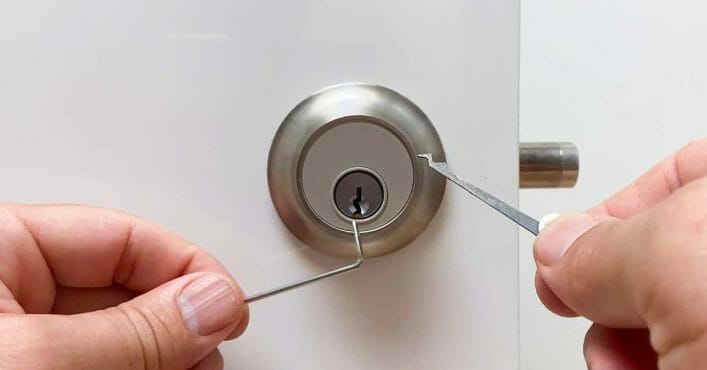Quick Navigation
Years ago I found myself locked out of my home on a Saturday evening coming back from dinner. With no locksmiths on call at that hour, I was lucky I had some training and knew how to get back into the house. Lock-picking is not as difficult as most think and most people can learn it, but mastering it requires time and effort.
A deadbolt lock is the most common lock in the world. In this guide, we teach you how to pick one so you don’t find yourself locked out of your home with nowhere to go.
What Will You Need to Pick a Deadbolt?
The tools you’ll need to pick a lock differ depending on the type of lock. Paperclips can be used as picks, and a tension wrench can be any tool that creates tension, such as a flathead screwdriver.
The pick itself is a long, stiff piece of metal or plastic that fits easily into the keyhole and does not flex readily when pushed against something. The other is a tension wrench made by bending a thin, stiff piece of metal or plastic at a 90-degree angle.
Both of these tools can be made from common home items. Paper clips, bobby pins, and electrical wires are the most frequent, but tooth-flossing handles can also be used in a pinch. Bobby pins are most likely the most effective.
How to Make the Wrench and the Pick

Tension wrenches and lock picks are used for lockpicking, but how are they made? Although stainless steel can be used for both, a butter knife for the lock pick and a wiper blade for the tension wrench is recommended.
A bobby pin lock pick is made by splitting a single bobby pin into two equal pieces or by using two bobby pins together. Remove the protective rubber nib from the bobby pin’s tip and straighten it out to make the pick, which is just a straight length of wire. (1)
To make the wrench, bend the pin’s end to a 90-degree angle. Bend the head of the pin instead of the tips if you’re building a wrench out of a whole bobby pin.
Lock-Picking Procedure and Steps

Lock-Picking Procedure Summary
The procedure for picking a lock is easy. With two simple tools, you can pick any keyed deadbolt lock.
- A Tension Wrench
- A lock pick or a lock pick set
- Place the tension wrench in the keyhole at the bottom of the deadbolt.
- Turn the tension wrench slowly and steadily to prevent the pins from falling back.
- Place the pick in the top of the lock keyhole and push the pins up, using the tension wrench to secure them in place.
- Remove the tension wrench and pick when the deadbolt opens.
Lock-Picking Steps
Although each lock is unique, the same basic concepts apply. Scrubbing is the quickest and most inefficient method of picking a lock.
Step 1: Gently Press the Tension Wrench into the Keyhole’s Bottom
Take your tension wrench and put it in the keyhole’s bottom. Apply a little pressure in the direction you’d turn the key if you had one. You’ll need enough give to allow the driver pins to rise beyond the shear line, but enough torque such that when they begin to drop, one edge of the drive pin snags the plug as it rotates.
Step 2: While Applying Light Torque to Your Wrench, Scrub Your Pick Back and Forth in the Keyhole
Continue to use your tension wrench with mild pressure. Scrub or rake the inside of the plug with your right hand while holding your pick. Lift up while pulling the pick back to provide pressure on the pins.
Step 3: Repeat Until all of the Pins Are Set.
Continue to apply torque with your wrench and scrape the pins until they are completely set. As you get close to the last one or two pins to set, you may need to apply extra torque and pressure to the pins using your pick. (2)
- Insert the short end of the wrench into the keyhole’s bottom while applying stress to the wrench handle in the direction of the lock’s rotation.
- Push the pick into the top of the lock until one of the pins is felt. You’ll eventually come across a pin that is more difficult to pull than the others. This is why you’ll need to use the tension wrench.
- Maintain tension on the wrench while lifting the pin. When the pin clears the barrel, it causes the barrel to move slightly, which is enough to keep it from sliding back.
- Continue jimmying up the pin and driving it in a little deeper until you’ve lifted all of them. At this point, you should be able to crank the lock with the wrench.
These tips on how to pick a deadbolt lock are beneficial if used properly and only when necessary. Knowing how to pick a deadbolt lock, can be useful.
You may check other picking guides below. Until our next article!
- How to pick a filing cabinet lock
- How to pick a garage door lock
- How to get a broken key out of a lock
References
(1) rubber – https://www.britannica.com/science/rubber-chemical-compound
(2) pressure – https://www.khanacademy.org/science/physics/fluids/density-and-pressure/a/pressure-article

